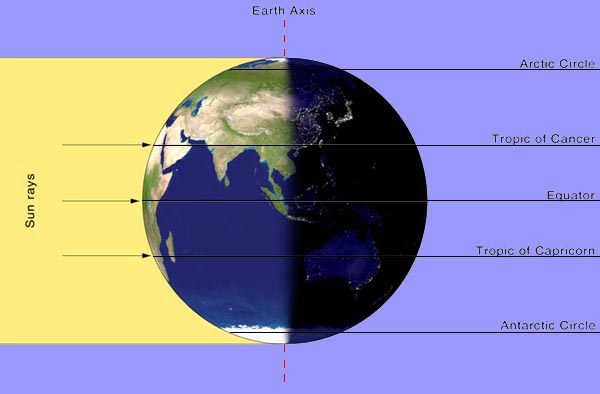 |
| Earth at the equinoxes (Wikipedia) |
Note: The March equinox, called by some the beginning of spring in the northern hemisphere, is the cue for several other observances as well.
Get Ready: Do you participate in Earth Hour or any other events around the March equinox?
For another lesson on this topic, see Lesson #03-020.
Although in the northern hemisphere spring technically begins around the start of February, March is the first month in which the change of season can be felt in northern regions. In fact, the name is derived from "Mars," the Roman God of War, since this is the month in which armies can begin to "march" again after the lifting of the damper placed on their activity by winter weather.
The spring equinox, then, is an important day on the calendar, marking (like its autumn counterpart) the halfway point between the winter and summer solstices. An actual day off in some countries (like Japan), it often passes unnoticed in others, especially in more tropical climes.
There are other observances marking this transitional day, however. One of these is Earth Hour, a fairly new international observance which was started by the World Wide Fund for Nature (WWF). On a particular day near the end of March, participants are encouraged to turn off their lights for one hour, from 8:30 to 9:30 p.m. (originally 8:00 to 9:00 p.m.) They may also eliminate all usage of electricity, including the charging of phones, the stand-by functions of TVs, etc.
This is a holiday close to my heart: good friends and I hosted the first-ever Earth Hour celebration in Shenzhen, China (though it happened to coincide with some in five-star hotels) on March 28, 2008, just one year after the observance was established in Australia in 2007. Meeting in a park, we had several speakers, acoustic music--and of course, no lights! The Shenzhen Daily sent a reporter to cover our event and gave it a full page in the March 31st edition that year.
--------
Many religious holidays owe their dates to the spring equinox as well. Easter (to be discussed in Lesson #05-019), for example, is the first Sunday after the first full moon after the Equinox and marks the end of Lent.
Lent itself, the 40-day season before Easter, makes a sly reference to the equinox. The English name "lent" is related to the word "length," because the days get longer approaching the equinox. It is, in fact, an archaic word for "spring"!
--------Read more: https://en.wikipedia.org/wiki/March_equinox
Practice: Match the term to its definition below:
- acoustic
- archaic
- climes
- counterpart
- damper
- sly
- stand-by functions
- transitional
- tropical
- unnoticed
- clever; secret
- something corresponding
- features to keep a device "warmed up"
- inhibition; something that keeps something else down
- regions (characterized by a climate)
- not amplified
- moving from one thing to another
- old-fashioned
- without coming to anyone's attention
- near the Equator
Answers are in the first comment below.
Submitted to the Shenzhen Daily for March 14, 2017


Answers to the Practice: 1. f; 2. h; 3. e; 4. b; 5. d; 6. a; 7. c; 8. g; 9. j; 10. i
ReplyDelete